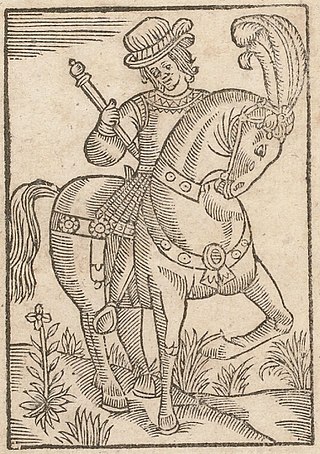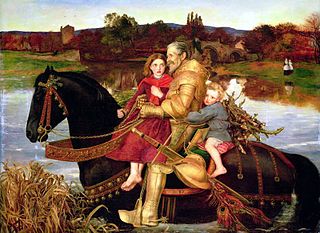Origins (Latin and Greek?)
The story is first mentioned in Latin by Venantius Fortunatus in his Carmina (Bk. vi. 8, 11. 5–6) during the late 6th century; [1] it is conjectured, based on similarities with the Ephesian Tale of Xenophon of Ephesus and the presence of idioms awkward in Latin but typical in Greek, that the original was a Greek romance of the third century. [2] Some fragments of Greek romance, however, point to the possibility of an even older date. [3] The earliest manuscripts of the tale, in a Latin version, date from the 9th or 10th century but are from late antiquity. Thus they show an intersection of Greek and Roman as well as pre-Christian and Christian influences. [4] Overall, the work is classed with other ancient Greek romance novels. [5]
Some scholars hold that the riddles with which the king tests the hero in many versions may be a later addition: [6] ten derive from the c. fourth-century Latin riddle-collection attributed to Symphosius. [7] Other scholars believe the incest story to have been a later addition as well, though others, including Elizabeth Archibald, see it as an integral thematic element of the tale. [8]
The most widespread Latin versions are those of Godfrey of Viterbo, who incorporated it into his Pantheon of 1185 as if it were actual history, Historia Apollonii regis Tyri and a version in the Gesta Romanorum . [9]
Translations
'Fifty to a hundred versions' of the story are known from antiquity into the early modern period, mostly European, including texts in English, Dutch, German, Danish, French, Spanish, Italian, Portuguese, Polish, Russian, Hungarian, Greek, and Latin. [10]
The earliest vernacular translation is an incomplete Old English prose text from the 11th century, sometimes called the first English novel. The existence of this unique text is unusual, as secular prose fiction from that time is extremely rare. The manuscript copy may only have survived because it was bound into a book together with Archbishop Wulfstan's homilies. [11] Various versions of the tale were later written in most European languages.
A notable English version is in the eighth book of John Gower's Confessio Amantis (1390), which uses it as an exemplum against lust. [1] It is described as being based on Pantheon, but it contains many details that work does not but the old Historia does. [12]
Its numerous vernacular versions, along with the Latin ones, attest to its popularity throughout the Middle Ages. [13] It appears in an old Danish ballad collected in Danmarks gamle Folkeviser . [14]
Robert Copland translated from the French the romance of Kynge Appolyne of Thyre (W. de Worde, 1510). [15]
According to the medieval poet Jean Bodel, the Matter of Rome is the literary cycle of Greek and Roman mythology, together with episodes from the history of classical antiquity, focusing on military heroes like Alexander the Great and Julius Caesar. Bodel's division of literary cycles also included the Matter of France and the Matter of Britain. The Matter of Rome includes the Matter of Troy, consisting of romances and other texts based on the Trojan War and its legacy, including the adventures of Aeneas.

Saint Eustace is revered as a Christian martyr. According to legend, he was martyred in AD 118, at the command of emperor Hadrian. Eustace was a pagan Roman general, who converted to Christianity after he had a vision of the cross while hunting. He lost all his wealth, was separated from his wife and sons, and went into exile in Egypt. Called back to lead the Roman army by emperor Trajan, Eustace was happily reunited with his family and restored to high social standing, but after the death of Trajan, he and his family were martyred under Hadrian for refusing to sacrifice to pagan Roman gods.

Guillaume de Palerme is a French romance poem, later translated into English where it is also known as William and the Werewolf. The French verse romance was composed c. 1200, commissioned by Countess Yolande. The prose version of the French romance, printed by N Bonfons, passed through several editions.
Floris and Blancheflour is the name of a popular romantic story that was told in the Middle Ages in many different vernacular languages and versions. It first appears in Europe around 1160 in "aristocratic" French. Roughly between the period 1200 and 1350 it was one of the most popular of all the romantic plots.
Gesta Romanorum, meaning Deeds of the Romans, is a Latin collection of anecdotes and tales that was probably compiled about the end of the 13th century or the beginning of the 14th. It still possesses a two-fold literary interest, first as one of the most popular books of the time, and secondly as the source, directly or indirectly, of later literature, in Geoffrey Chaucer, John Gower, Giovanni Boccaccio, Thomas Hoccleve, William Shakespeare, and others.

As a literary genre, the chivalric romance is a type of prose and verse narrative that was popular in the noble courts of high medieval and early modern Europe. They were fantastic stories about marvel-filled adventures, often of a chivalric knight-errant portrayed as having heroic qualities, who goes on a quest. It developed further from the epics as time went on; in particular, "the emphasis on love and courtly manners distinguishes it from the chanson de geste and other kinds of epic, in which masculine military heroism predominates."

The Seven Wise Masters is a cycle of stories of Sanskrit, Persian or Hebrew origins.

Sir Isumbras is a medieval metrical romance written in Middle English and found in no fewer than nine manuscripts dating to the fifteenth century. This popular romance must have been circulating in England before 1320, because William of Nassyngton, in his work Speculum Vitae, which dates from this time, mentions feats of arms and other 'vanities', such as those found in stories of Sir Guy of Warwick, Bevis of Hampton, Octavian and Sir Isumbras. Unlike the other three stories, the Middle English Sir Isumbras is not a translation of an Old French original.
"Le Fresne" is one of the Lais of Marie de France. It was likely written in the late 12th century. Marie claims it to be a Breton lai, an example of Anglo-Norman literature.
Emaré is a Middle English Breton lai, a form of mediaeval romance poem, told in 1035 lines. The author of Emaré is unknown and it exists in only one manuscript, Cotton Caligula A. ii, which contains ten metrical narratives. Emaré seems to date from the late fourteenth century, possibly written in the North East Midlands. The iambic pattern is rather rough.

Ipomadon is a Middle English translation of Hugh of Rhuddlan's Anglo-Norman romance Ipomedon composed in tail-rhyme verse, possibly in the last decade of the fourteenth century. It is one of three Middle English renditions of Hugh's work: the other two are a shorter verse Lyfe of Ipomydon and the prose Ipomedon, both of the fifteenth century. Each version is derived independently from the Anglo-Norman Ipomedon, which Hugh wrote 'not long after 1180', possibly in Herefordshire. It is included in a list of the popular English romances by Richard Hyrde in the 1520s.
Generides or Generydes is an English verse romance, originating in the English Midlands and dated to the end of the 14th century. It survives in two different lengthy forms. The hero Generides is born as an illegitimate son of the King of India, and after adventures marries a princess of Persia and becomes ruler of both India and Persia.
Le Bone Florence of Rome is a medieval English chivalric romance. Featuring the innocent persecuted heroine, it is subcategorized into the Crescentia cycle of romances because of two common traits: the heroine is accused by her brother-in-law after an attempted seduction, and the story ends with her fame as a healer bringing all her persecutors to her.
The Erl of Toulouse is a Middle English chivalric romance centered on an innocent persecuted wife. It claims to be a translation of a French lai, but the original lai is lost. It is thought to date from the late 14th century, and survives in four manuscripts of the 15th and 16th centuries. The Erl of Toulouse is written in a north-east Midlands dialect of Middle English.
Amadas, or Sir Amadace is a medieval English chivalric romance, one of the rare ones for which there is neither a known nor a conjectured French original, like Sir Eglamour of Artois. The hero shares a name but no more with the romance Amadas et Idoine.
Roswall and Lillian is a medieval Scottish chivalric romance. A late appearing tale, it nevertheless draws heavily on folkloric motifs for its account of an exiled prince, reduced to poverty, who rises from it to win a princess.
Crescentia is an Early Middle High German language chivalric romance, included in the Kaiserchronik about 1150. Other versions appeared in the thirteenth and fourteenth centuries, in prose and verse.

Athelston is an anonymous Middle English verse romance in 812 lines, dating from the mid or late 14th century. Modern scholars often classify it as a "Matter of England" romance, because it deals entirely with pre-Conquest English settings and characters. It is mainly written in twelve-line stanzas rhyming AABCCBDDBEEB, though the poet occasionally varies his meter with stanzas of eight, six, or four lines. The poem survives in only one manuscript, the early 15th-century Gonville and Caius MS 175, which also includes the romances Richard Coer de Lyon, Sir Isumbras and Beves of Hamtoun. It has no title there. Athelston was first printed in 1829, when C. H. Hartshorne included it in his Ancient Metrical Tales.
The Libro de Apolonio is an anonymous work of medieval Spanish literature written in Alexandrine quatrains around the middle of the thirteenth century in the learned genre of the Mester de clerecía. It is based on the medieval Latin Historia Apolonii Regis Tyrii.
Exeter Book Riddle 60 is one of the Old English riddles found in the later tenth-century Exeter Book. The riddle is usually solved as 'reed pen', although such pens were not in use in Anglo-Saxon times, rather being Roman technology; but it can also be understood as 'reed pipe'.








